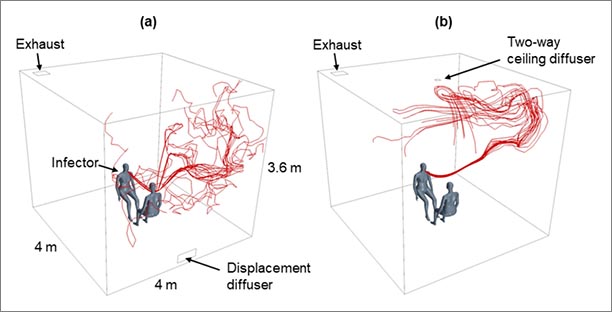
Room ventilation can drastically change the rate of transmission from an infected person to another, even when spaced two meters apart. IMAGE: DONGHYUN RIM/PENN STATE
Physical distance may not be enough to prevent viral aerosol exposure indoors
Architectural engineering team investigated the effects of physical distancing, building ventilation as control strategies
9/13/2021
By Ashley J. WennersHerron
UNIVERSITY PARK, Pa. — Eighteen months ago, stickers began to dot the floors of most shops, spaced about six feet apart, indicating the physical distance required to avoid the COVID-19 virus an infected person may shed when breathing or speaking. But is the distance enough to help avoid infectious aerosols?
Not indoors, say researchers in the Penn State Department of Architectural Engineering. The team found that indoor distances of two meters — about six and a half feet — may not be enough to sufficiently prevent transmission of airborne aerosols. Their results were made available online ahead of the October print edition of Sustainable Cities and Society.
“We set out to explore the airborne transport of virus-laden particles released from infected people in buildings,” said Gen Pei, first author and doctoral student in architectural engineering at Penn State. “We investigated the effects of building ventilation and physical distancing as control strategies for indoor exposure to airborne viruses.”
The researchers examined three factors: the amount and rate of air ventilated through a space, the indoor airflow pattern associated with different ventilation strategies and the aerosol emission mode of breathing versus talking. They also compared transport of tracer gas, typically employed to test leaks in air-tight systems, and human respiratory aerosols ranging in size from one to 10 micrometers. Aerosols in this range can carry SARS-CoV-2.
“Our study results reveal that virus-laden particles from an infected person’s talking — without a mask — can quickly travel to another person’s breathing zone within one minute, even with a distance of two meters,” said Donghyun Rim, corresponding author and associate professor of architectural engineering. “This trend is pronounced in rooms without sufficient ventilation. The results suggest that physical distance alone is not enough to prevent human exposure to exhaled aerosols and should be implemented with other control strategies such as masking and adequate ventilation.”

Displacement ventilation (left), used in most homes, can increase the rate of transmission of aerosols from one person to another seven times quicker than mixed-mode ventilation (right), which is found in many commercial buildings. IMAGE: DONGHYUN RIM/PENN STATE
The researchers found that aerosols traveled farther and more quickly in rooms with displacement ventilation, where fresh air continuously flows from the floor and pushes old air to an exhaust vent near the ceiling. This is the type of ventilation system installed in most residential homes, and it can result in a human breathing zone concentration of viral aerosols seven times higher than mixed-mode ventilation systems. Many commercial buildings use mixed-mode systems, which incorporate outside air to dilute the indoor air and result in better air integration — and tempered aerosol concentrations, according to the researchers.
“This is one of the surprising results: Airborne infection probability could be much higher for residential environments than office environments,” Rim said. “However, in residential environments, operating mechanical fans and stand-alone air cleaners can help reduce infection probability.”
According to Rim, increasing the ventilation and air mixing rates can effectively reduce the transmission distance and potential accumulation of exhaled aerosols, but ventilation and distance are only two options in an arsenal of protective techniques.
“Airborne infection control strategies such as physical distancing, ventilation and mask wearing should be considered together for a layered control,” Rim said.
The researchers are now applying this analysis technique to various occupied spaces, including classrooms and transportation environments.
Mary Taylor, a graduate student at Penn State at the time of the research, also contributed to this work, which was supported by the National Science Foundation.



